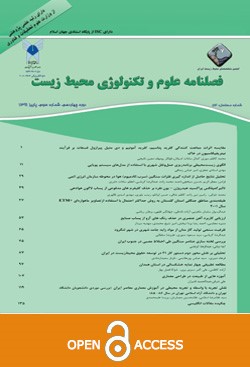Removal of Cationic Dye Malachite Green from Aqueous Solutions Using a Mixture of Carrageenan and Sodium Alginate Biopolymers in the Presence of Montmorillonite Nanoclay
Subject Areas : Water and Environment
Behjat Farrokhi
1
,
Nasim Ziaefar
2
![]() ,
Hossein Sheikhloie
3
,
Hossein Sheikhloie
3
1 - Student of Master of Science of applied Chemistry, Department of Chemistry, Maragheh branch, Islamic Azad University, Maragheh, Iran
2 - Assistant Prof. of applied Chemistry, Department of Chemistry, Maragheh branch, Islamic Azad University, Maragheh, Iran
3 - Assistant Prof. of Analytical Chemistry, Department of Chemistry, Maragheh branch, Islamic Azad University, Maragheh, Iran
Keywords: Biopolymer, Removal of cationic malachite green dye, Carrageenan, Alginate sodium, Montmorillonite,
Abstract :
Background and Objectives: Cationic dye malachite green is one of the most important toxic compounds in industrial wastewater. Typically, physicochemical or biological methods are used to water treatment and wastewater containing high concentrations of malachite green. In the present study nanocomposite hydrogels based on carrageenan and sodium alginate in the presence of sodium montmorillonite as Nano clay were synthesized and then used to study the absorption of malachite green from aqueous samples. Methods: Acrylamide was used as a monomer, methylene base acrylamide as an organic cross linker and potassium sulfate as an initiator. The adsorption of cationic dye malachite green by the nanocomposite hydrogels was investigated. The structures of nanocomposite hydrogels were investigated by (FTIR, XRD and SEM) techniques. The effect analytical parameters such as pH, contact time for the removal of dye material by synthesized nanocomposite hydrogels were investigated and optimal conditions were obtained. Finding: According to the results, synthesized nanocomposite hydrogels are sensitive to pH and changes in the amount of carrageenan and sodium alginate. Equilibrium absorption time is 3 hours. The absorption isotherm with Langmuir model and absorption kinetics was more suitable for pseudo-second order kinetic models. Discussion & Conclusion: The rate of removal of malachite green dye increases with increasing amount of Nano clay in the acidic medium. Finally, it can be concluded that the bio-polymer mixture of carrageenan and sodium alginate in the presence of sodium montmorillonite nanoclay is a suitable absorbent to remove the malachite green dye from aqueous solutions.
alumina reinforced polystyrene, Clean-Soil, Air, Water, Vol. 39, pp. 74-82
6. Po, R., 1994, Water-absorbent polymers, a patent survey, J.Macromol. Sci.-Rev. Macromol. Chem. Phys, C34, pp. 607-661.
10. Pourjavadi, A., Zohuriaan-Mehr, M.J., 2003, Superabsorbent hydrogels from starch-g-PAN: effect of some reaction on swelling behavior, J. Polym. Mater., Vol. 20, pp. 113-120.
_||_
alumina reinforced polystyrene, Clean-Soil, Air, Water, Vol. 39, pp. 74-82
6. Po, R., 1994, Water-absorbent polymers, a patent survey, J.Macromol. Sci.-Rev. Macromol. Chem. Phys, C34, pp. 607-661.
10. Pourjavadi, A., Zohuriaan-Mehr, M.J., 2003, Superabsorbent hydrogels from starch-g-PAN: effect of some reaction on swelling behavior, J. Polym. Mater., Vol. 20, pp. 113-120.


